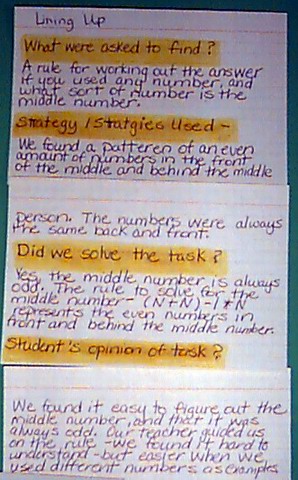 |
If the guiding objective of the curriculum is to teach students to work like a mathematician, then recording and publishing are appropriate because that's what mathematicians do. However, what to record, how often to record and in what form to record are management issues faced by all teachers using tasks. Each aspect can take several forms:
- Recording might be on a teacher-designed sheet or in a journal/diary/drafting book.
- Publishing might be as a display, a video, a PowerPoint presentation, a paragraph in the the school newsletter, a report to the local paper, and so on.
Teachers cannot assume students understand what it means to publish in mathematics. To do so is a genre of 'writing' and it has to be modelled. You must teach what it means to prepare a maths report and students must see models of what you expect in a 'good' report.
Using the lesson below Learning to Write a Maths Report will help your students learn the publishing process. It is based around Task 45, Eric The Sheep, and includes a student PowerPoint presentation. However, you can adapt the lesson to be used with the whole class investigation life of any task.
Other examples from various classrooms suggest several ways recording and publishing can be developed.
Additional contributions from your classroom are welcome.
|

Task 65, Shape Algebra

Task 11, Lining Up
|

Recording
 Recording at Ashburton Primary School Recording at Ashburton Primary School
...a first try at recording task work in Years 4 & 5 and
examples of development over a term in Year 4.
 Journal Entries for Red to Blue Journal Entries for Red to Blue
...Year 8, Lilydale High School
 Video Recording of Red to Blue Solution Video Recording of Red to Blue Solution
...Year 6, Camberwell Primary School
 Journals at Trinity Academy Journals at Trinity Academy
...introducing Home/School lending
 Recording at Settlebeck High School Recording at Settlebeck High School
...a first pass at recording Task investigations
 Nic Dale's Story Nic Dale's Story
...student journals as evidence of PD changing teaching
practice
 Home/School Lending Home/School Lending
...one school's approach to including parents
|
Publishing
 Learning to Write a Maths Report Learning to Write a Maths Report
...teaching notes for a lesson modelling report preparation
 Learning to Write a Maths Report 2 Learning to Write a Maths Report 2
...5 Square Reporting scaffold (includes student work sample)
 Sample Maths Reports from Mackillop College Sample Maths Reports from Mackillop College
The school integrates tasks into the curriculum. They invite students to work on tasks in depth, sometimes led beyond the card using an Investigation Guide, and to report on their investigations. These two reports are from different Year 10 students who investigated Task 101, Pyramid Puzzle.
The reports are useful for what they show of the students' work, but also because they illustrate how their teacher, Damian Howison, has added encouraging and supportive comments to their reports electronically. Damian's comments are based on an assessment rubric the staff designed and refined over time. You can find that on our Assessment page.
Damian has also submitted this report by Connor Gibbins, Year 7, on Task 82, Snail Trail. You can also read about the process the school has developed to encourage this level of report writing.
 Posters from Wade High School Posters from Wade High School
...displays from a unit of investigation work
 PowerPoint at St Monica's School, Evatt PowerPoint at St Monica's School, Evatt
...learn about a task and then read in From The Classroom
why the students developed a PowerPoint to 'teach the
other teachers'
 PowerPoint from Settlebeck High School PowerPoint from Settlebeck High School
...slide show reports on investigations
 Slide Show from Hillston Central School Slide Show from Hillston Central School
Hi Doug,
Attached is a presentation on Eric the Sheep produced by Tiana and Emma, from Year 7 at Hillston Central School. They selected Eric the Sheep as their task to present to Mr Smyth's maths class. The students in this class have really enjoyed the Working Mathematically approach using the Maths With Attitude kits. They did their presentation in Powerpoint, which has been converted to a pdf.
Thanks, Graeme
 Two Reports of Task 182, Jumping Kangaroos Two Reports of Task 182, Jumping Kangaroos
...one Year 6 and one Year 7
|

More from the Mathematics Task Centre
|